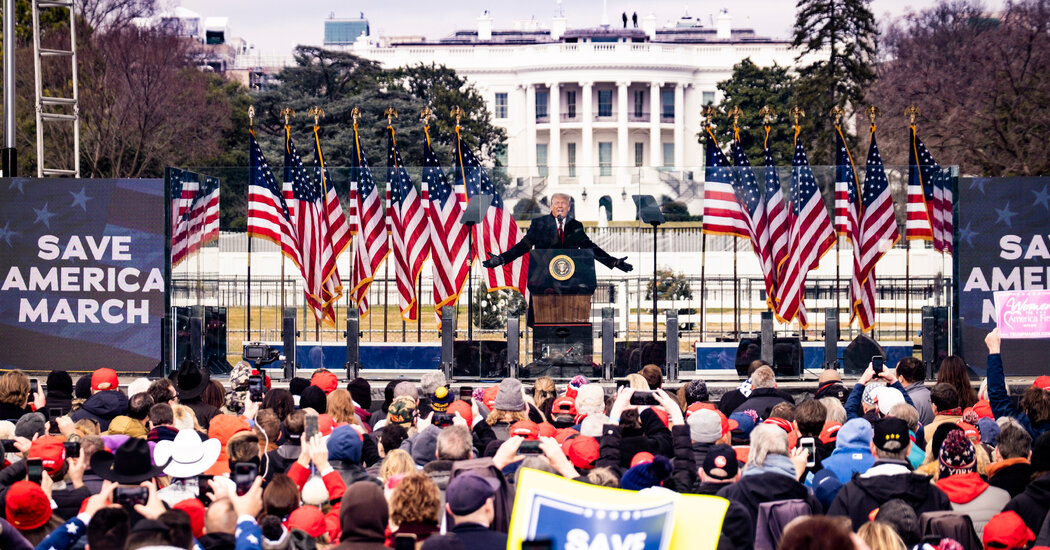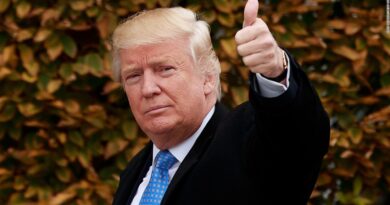‘Be There. Will Be Wild!’: Trump All but Circled the Date

For weeks, President Trump and his supporters had been proclaiming Jan. 6, 2021, as a day of reckoning. A day to gather in Washington to “save America” and “stop the steal” of the election he had decisively lost, but which he still maintained — often through a toxic brew of conspiracy theories — that he had won by a landslide.
And when that day came, the president rallied thousands of his supporters with an incendiary speech. Then a large mob of those supporters, many waving Trump flags and wearing Trump regalia, violently stormed the Capitol to take over the halls of government and send elected officials into hiding, fearing for their safety.
But if the chaos in the Capitol shocked the country, one of the most disturbing aspects of this most disturbing day was that it could be seen coming. The president himself had all but circled it on the nation’s calendar.
“Big protest in D.C. on January 6th,” Mr. Trump tweeted on Dec. 19, just one of several of his tweets promoting the day. “Be there, will be wild!”
And his supporters took the president at his word.
“If you are not prepared to use force to defend civilization, then be prepared to accept barbarism,” a member of the Red-State Secession group on Facebook posted on Tuesday, the eve of the appointed day, Jan. 6.
Beneath it, dozens of people posted comments that included photographs of the weaponry — including assault rifles — that they said they planned to bring to the rally. There were also comments referring to “occupying” the Capitol and forcing Congress to overturn the November election that Joseph R. Biden Jr. had won — and Mr. Trump had lost.
Renée DiResta, a researcher who studies online movements at the Stanford Internet Observatory, said that the violent disruption at the Capitol on Wednesday was the result of online movements operating in closed social media networks where claims of voter fraud and a stolen election found oxygen.
“This is a demonstration of the very real-world impact of echo chambers,” Ms. DiResta said.
The roots of one of the darkest moments in American democracy reached at least as far back as Nov. 4, the day after the presidential election that Mr. Trump would decisively lose to Mr. Biden. On that day, the first Stop the Steal group was formed on Facebook — and it quickly took off, realizing at one point 100 new members every 10 seconds. The group swelled to 320,000 followers before Facebook shut it down.
As hundreds of new Stop the Steal groups continued to pop up, Facebook became more aggressive in shutting them down, prompting some far-right supporters of Mr. Trump — including some involved in militias and conspiracy groups — to move to new, less-restrictive social media sites, including Parler and Gab. And it was on these sites that a movement to organize a pro-Trump protest rally in Washington gathered momentum.
Several right-wing activists, including Ali Alexander, a Republican operative who was previously known as Ali Akbar, began to emerge as leaders of Stop the Steal. Their conspiracy theories and fact-free claims of electoral fraud closely mirrored the same baseless charges being leveled by Mr. Trump.
By mid-December, dozens of lawsuits filed by Trump supporters had failed, often miserably. Then, on Dec. 14, Mr. Biden secured enough votes in the Electoral College to affirm his victory. The last formality before his inauguration on Jan. 20 was the official count by Congress of electoral votes, a pro forma ceremony of paperwork, to be overseen by Vice President Mike Pence.
On Jan. 6.
Mr. Alexander and others seized on the date, urging Trump supporters everywhere to converge onto the Capitol as Congress tended to what historically has been a glorified shuffling of papers — if sometimes infused with grace, as when Vice President Al Gore announced the names of the winner, George W. Bush, and the loser: Al Gore.
The Presidential Transition
Jan. 8, 2021, 1:53 a.m. ET
The moment has traditionally been seen as another reassurance of the transfer of power in the Republic. But Mr. Trump and his supporters were publicly framing this year’s formality as criminal, fraudulent — even treasonous.
As his aides and supporters did what they could to forestall the inevitable — a lawsuit by the Texas congressman Louie Gohmert, a 36-page report alleging election fraud by the Trump adviser Peter Navarro — Mr. Trump continued tweeting.
Dec. 27: “See you in Washington, DC, on January 6th. Don’t miss it. Information to follow.”
Dec. 30: “JANUARY SIXTH, SEE YOU IN DC!”
Jan. 1: “The BIG Protest Rally in Washington, D.C. will take place at 11:00 A.M. on January 6th. Locational details to follow. StopTheSteal!”
That same day, a supporter misspelled the word “cavalry” in tweeting that “The calvary is coming, Mr. President!”
Mr. Trump responded: “A great honor!”
The next day, Jan. 2, Senator Ted Cruz of Texas and 11 other Republican senators joined another Republican, Josh Hawley of Missouri — as well as more than 100 Republican members of the House of Representatives — in vowing to object to the certification of Mr. Biden’s election.
By now, the extreme fringes of Trump supporters — including the Proud Boys and other groups known to incite violence, as well as conspiracy groups like QAnon — were exploring what they might do on Jan. 6 in Washington. On dedicated chats in Gab they discussed logistics of where to gather and what streets they would take to the Capitol. The Red-State Secession Facebook page even encouraged its 8,000 followers to share the addresses of “enemies,” including those for federal judges, members of Congress and well-known progressives.
A sense of the percolating trouble came with a widely circulated video of a Trump supporter confronting Senator Mitt Romney, the Utah Republican and a frequent Trump critic, at Salt Lake International Airport as he awaited a flight Tuesday to Washington. When the supporter asked why he hadn’t supported the president’s claims of electoral fraud, Mr. Romney said that he would follow the Constitution.
“I wouldn’t be surprised if you weren’t even voted in legally,” the person said as she followed the senator to the gate. “You’re a joke, absolute joke, it’s a disgusting shame.”
Meanwhile, members of the Red-State Secession Facebook page were conversing in the language of insurrection.
Then dawned Jan. 6, the day of reckoning. Thousands gathered in downtown Washington, forming rivers of Trump red that commingled the Trump and American flags. The crowd included between 2,000 and 2,500 members of the Proud Boys, according to Enrique Tarrio, the group’s chairman.
Any hope that Mr. Pence would block the congressional confirmation of Mr. Biden’s election — thereby acquiescing to immense pressure being applied by Mr. Trump — was dashed before noon. Mr. Pence said in a letter that the vice president did not have such power.
“The presidency belongs to the American people, and to them alone,” he wrote.
Then, at noon, Mr. Trump began to deliver a speech to his excited followers.
In the afternoon hours to come, Mr. Trump would excoriate his vice president for not having “the courage to do what should have been done to protect our Country and our Constitution.” In the hours to come, his supporters, carrying flags and wearing clothes that bore his name, would rush the Capitol in a terrifying swirl of chaos that would force a lockdown and leave one woman shot dead.
Among those who swarmed into the Capitol would be well-known QAnon characters and white supremacists. Jake Angeli, a QAnon supporter known for his painted face and horned hat, roamed the Senate floor. Tim Gionet, a neo-Nazi conspiracy theorist known as “Baked Alaska,” would take over a Senate office.
But first came the remarks of the president, delivered on the Ellipse, just south of the White House.
“We will never give up,” he said. “We will never concede. It will never happen. You don’t concede when there’s theft involved. Our country has had enough. We will not take it anymore.”
Mr. Trump concluded his 70-minute exhortation by encouraging everyone to walk down Pennsylvania Avenue to give Republicans at the Capitol “the kind of pride and boldness that they need to take back our country.” Then the president of the United States returned to the White House, at a safe distance from the mayhem that was to unfold.
Alan Feuer contributed reporting. Kitty Bennett and Jack Begg contributed research.
*** This article has been archived for your research. The original version from The New York Times can be found here ***


